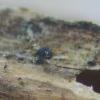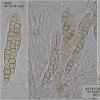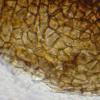
26-12-2025 21:19
Arnold BüschlenPithyella chalaudii Priou. Ist als Bryoparasit in

21-12-2025 09:32
Hello.A tiny ascomycete found embedded in wood in

18-12-2025 21:17
Pol DebaenstThe identification took me to Byssonectria deformi

24-12-2025 17:08
Hulda Caroline HolteHello, I have found this propoloid ascomycete on

21-12-2025 21:32
Pol DebaenstHello, Garden, Burgweg 19, Veurne, BelgiumOn 10/1
Small ascomata on herbaceous stems.
I do not identify
Have you some idea
Thank you. regards
Susana

There (1984) in the key for determination:
2b. Spores with sheath .............................................................................. 8
................. 80. Ascocarps less than 200 mikroms wide....... 9
9tr. Spores up to 8 mikom wide, finally echinulate: on Xeroplryllum .............................. Leptosphaeria xerophylli
911. Spores 8- 11 pm wide, smooth: on Agastache ...................................... L. brightonensis.
8b. Ascocarps more than 200 mikrom wide ........................................................ I0.
Try to identify the host plant ...

your species is most probably a member of Leptosphaeria. I think it is close to L. doliolum which has typically 3septated spores in pale grey-brown colours.
regards,
björn
For now I can say it's Leptosphaeria sp. Thank you.
L. Doliolum would have the extremes of the spores acute. It could be L.conoidea?
Ascocarp Size: 270 x 220 um
Spores not seen to have ornamentation or sheath
The host, impossible to determine.
Can someone give me the monograph mentioned?
I would also like to get:
SHOEMAKER, R. A. (1984a) - Canadian and some extralimital Leptosphaeria species. Canada. J. Bot. 62: 2688-2729.
regards
Susana

I am also interested in Shoemakers Leptosphaeria in Can. J. Bot. 62.
regards,
björn
Thank you
Enrique
I'm also interested in Shoemaker's Phaeopsphaeria monograph :)
Thanks in advance - LUC.
About this sample: it's rather a Phaeosphaeria (peridium rather thin and transluscent) that a Leptosphaeria s.str. (peridium thick and black, not transluscent).


